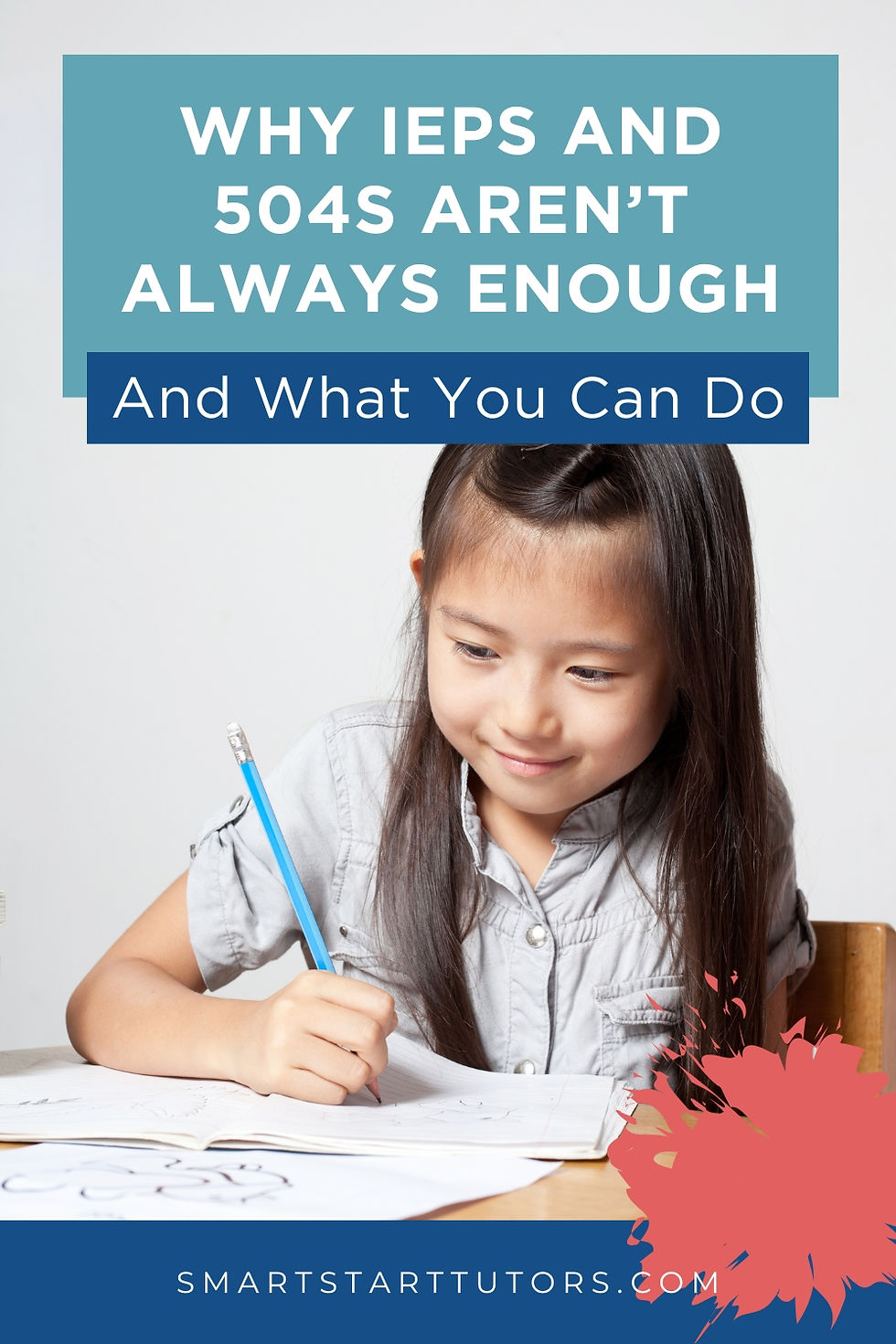The Gaps in IEPs and 504 Plans (And How You Can Fill Them)
- smartstarttutorsin
- Aug 20
- 3 min read
If you're a parent of a struggling reader in grades K–5, chances are you've heard of, or maybe even fought hard for, an IEP or 504 Plan.
These formal supports can be incredibly helpful. They’re often the first step in getting your child the help they need at school.
But here’s the honest truth: an IEP or 504 plan doesn’t always go far enough, especially when it comes to addressing the why behind your child’s reading challenges or giving them the targeted support they need to catch up.
As online Reading Specialists, we work with students who have IEPs, 504s, or no formal plan at all. And what they all have in common is this: they’re not reading on grade level yet, and their parents are looking for answers and real progress.

IEPs and 504 Plans: What's the Difference?
Before we dive into what they don’t cover, let’s clarify what these plans are:
IEP (Individualized Education Program): A legal document under IDEA that outlines special education services for students with a qualifying disability. It includes specific goals, accommodations, and sometimes specialized instruction.
504 Plan: Provides accommodations and modifications to help students with disabilities access the general education curriculum, but it doesn’t typically include specialized instruction.
Both are valuable tools. But they’re not always enough on their own.
What IEPs and 504 Plans Often Miss
Even with a plan in place, many parents still feel like their child isn’t getting what they need. Why?
Here are a few gaps we see all the time:
1. Lack of Intensive, Personalized Instruction
Schools do their best, but they’re often juggling large caseloads and limited resources. Your child may get small-group support, but that doesn’t always mean it’s the right approach for your child’s brain or learning style.
2. Not Enough Frequency or Duration
Maybe your child gets reading help twice a week for 20 minutes. For many struggling readers, that’s just not enough to close the gap.
3. One-Size-Fits-All Support
IEPs and 504s don’t always specify how a child should be taught. And what works for one student with dyslexia, ADHD, or a processing issue might not work for another.
4. No Clear Plan for What Happens at Home
Parents are often told, “Just read more at home,” but what if reading is a daily battle? What if your child avoids it, melts down, or gets discouraged because they know they’re behind?
This is where we come in.
How to Fill the Gaps at Home, with the Right Support
Our Orton-Gillingham trained tutors specialize in working with students in grades K–5 who are behind in reading, whether slightly behind or significantly delayed.
We support students with dyslexia, ADD, ADHD, and processing challenges, and we also work with children who are eager to learn but just aren’t quite there yet.
Here’s how we help fill the gap between what school provides and what your child actually needs to grow as a reader:
One-on-One Online Reading Support
We meet your child where they are, with instruction tailored to their pace, personality, and learning profile.
Research-Based, Proven Methods
We use strategies that are designed to work with how the brain learns to read, especially for students with learning differences.
Focus on Confidence and Independence
It’s not just about decoding words. It’s about building confidence, stamina, and a love for learning, so your child can thrive in the classroom and beyond.
Parent Partnership
We don’t leave you guessing. We provide ongoing updates, easy-to-implement strategies you can use at home, and a team that’s rooting for your child every step of the way.
IEPs and 504 plans are helpful, but they’re not the whole picture.
If your gut is telling you your child needs more support, you’re probably right. And you don’t have to figure it out alone.
Want to learn more about how we can support your child’s reading journey? Contact us for a consultation!





Everything you have provided here is so useful. Really understanding the difference between an IEP and a 504 plan is incredibly important. Knowing what the difference is, and then what it can and sometimes what it can't do, is also important for parents to understand.
Because, the classroom size is often for this on both sides can be so big that it's really hard to get specific results. They're dealing with kids who also have other IEPs and 504s, and it really adds a strain into the classroom environment to provide all of these accommodations and all of the pull-out times. Kids are going to get pulled out here to be able to work on this skill and get pulle…